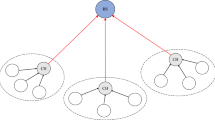Abstract
Recent research in mobile ad-hoc networks (MANETs) mostly deals to minimize the broadcast expenses of route discovery by controlling the query-broadcast. In this regard, a variety of broadcast-repealing schemes have been proposed, and employed to improve effectiveness and efficiency in various aspects of route-discovery considering time and energy. These schemes mainly focus on reducing unnecessary propagation of route-query by repealing the query-broadcast. Time-to-live based broadcast is the most common controlled-flooding scheme widely used in routing protocols. Recently some other broadcast-repealing schemes are proposed which work based on chasing-policy. The critical and analytical assessment to evaluate these schemes such aspects is of great importance. In this paper, we investigate their query-diffusion process, and their merits and demerits.
















Similar content being viewed by others
Notes
Broadcast repealing is used to control flooding, terms broadcast repealing and controlled flooding are used interchangeably to define query-control techniques.
One hop away neighbor nodes form first ring, two hop away nodes form second ring and so on.
Route no longer exists due to frequently changing topology
The terms participating nodes and intermediate nodes interchangeably are used to define the relay nodes
To avoid redundancy of query at intermediate nodes.
Route-node that has destination information
Abbreviations
- ERS:
-
Expanding Ring Search
- AODV:
-
Ad-hoc On-demand Distance Vector
- MAODV:
-
Multicast Ad hoc On-Demand Distance Vector
- ODMRP:
-
On-Demand Multicast Routing Protocol
- BERS:
-
Blocking Expanding Ring Search
- BERS+:
-
Enhanced BERS
- BERS*:
-
Blocking Expanding Ring Search*
- tBERS:
-
Time efficient-BERS
- tBERS*:
-
Time efficient-BERS*
- BCIR:
-
Broadcast Cancellation Initiated on Resource
- MBERS+:
-
Modified BERS+
- CMBERS+:
-
Cluster based MBERS+
References
Abbasi, A. A., & Younis, M. (2007). A survey on clustering algorithms for wireless sensor networks. Computer Communications, 30(14), 2826–2841.
Ahmad, N., & Hussain, S. Z. (2015). Broadcast expenses controlling techniques in mobile ad-hoc networks: A survey. Journal of King Saud University-Computer and Information Sciences, 28, 248–261.
Ahmad, N., & Hussain, S. Z. (2017). Power saving technique for controlled broadcast of query packet in manets. International Journal of Mobile Network Design and Innovation, 7(3), 281–293.
Al-Rodhaan, M. A., Mackenzie, L., & Ould-Khaoua, M. (2008). Improvement to blocking expanding ring search for manets (pp. 1–13). Glasgow: Dept of Computing Science, University of Glasgow.
Chang, N., & Liu, M. (2004). Revisiting the ttl-based controlled flooding search: Optimality and randomization. In Proceedings of the 10th annual international conference on Mobile computing and networking (pp. 85–99). ACM.
Choi, W., & Woo, M. (2006). A distributed weighted clustering algorithm for mobile ad hoc networks. In Proceeding of advanced international conference on telecommunications/international conference on internet and web applications and services, AICT-ICIW’06 (pp. 73–73). IEEE.
Gui, B., Dai, L., & Cimini, L. J, Jr. (2009). Routing strategies in multihop cooperative networks. IEEE Transactions on Wireless Communications, 8(2), 843–855.
Hussain, S. Z., & Ahmad, N. (2017). Minimizing broadcast expenses in clustered ad-hoc networks. Journal of King Saud University—Computer and Information Sciences. http://www.sciencedirect.com/science/article/pii/S1319157816300258.
Karenos, K., Kalogeraki, V., & Krishnamurthy, S. V. (2008). Cluster-based congestion control for sensor networks. ACM Transactions on Sensor Networks (TOSN), 4(1), 5.
Lee, S. J., Su, W., & Gerla, M. (2002). On-demand multicast routing protocol in multihop wireless mobile networks. Mobile Networks and Applications, 7(6), 441–453.
Lima, R., Baquero, C., & Miranda, H. (2013). Broadcast cancellation in search mechanisms. In Proceedings of the 28th Annual ACM Symposium on Applied Computing (pp. 548–553). SAC ’13, ACM, New York, NY, USA.
Park, I., Kim, J., & Pu, I., et al. (2006). Blocking expanding ring search algorithm for efficient energy consumption in mobile ad hoc networks. In WONS 2006: Third annual conference on wireless on-demand network systems and services (pp. 191–195).
Perkins, C. E., & Royer, E. M. (1999). Ad-hoc on-demand distance vector routing. In Second IEEE workshop on mobile computing systems and applications, 1999. proceedings. WMCSA’99 (pp. 90–100). IEEE.
Pu, I. M., & Shen, Y. (2009). Enhanced blocking expanding ring search in mobile ad hoc networks. In 2009 3rd international conference on new technologies, mobility and security (NTMS) (pp. 1–5). IEEE.
Pu, I. M., & Shen, Y. (2010). Analytical studies of energytime efficiency of blocking expanding ring search. Mathematics in Computer Science, 3(4), 443–456.
Pu, I. M., Stamate, D., & Shen, Y. (2014). Improving time-efficiency in blocking expanding ring search for mobile ad hoc networks. Journal of Discrete Algorithms, 24, 59–67.
Pu, I., Kim, J., & Shen, Y. (2010). Energy-time efficiency of two routing strategies with chase packets in expanding ring search. In 2010 IEEE 17th international conference on telecommunications (ICT) (pp. 742–747).
Zeeshan, S. H., & Naeem, A. (2014). Cluster based controlling of route exploring packets in ad-hoc networks. In Proceedings of the 2nd international conference on advanced computing, networking, and informatics, ICACNI’14. vol. 28.
Shamoun, S., & Sarne, D. (2014). Two-sided expanding ring search. In Proceedings of 6th international conference on communication systems and networks, COMSNETS’14 (pp. 1–8). IEEE.
Tonguz, O. K., Wisitpongphan, N., Parikh, J. S., Bai, F., Mudalige, P., & Sadekar, V. K. (2006). On the broadcast storm problem in ad hoc wireless networks. In: 3rd international conference on broadband communications, networks and systems, 2006. BROADNETS 2006 (pp. 1–11). IEEE.
Williams, B., & Camp, T. (2002). Comparison of broadcasting techniques for mobile ad hoc networks. In Proceedings of the 3rd ACM international symposium on Mobile ad hoc networking and computing (pp. 194–205). ACM.
Zhu, Y., & Kunz, T. (2004). Maodv implementation for ns-2.26. Systems and Computing Engineering, Carleton University, Technical Report SCE-04-01.
Author information
Authors and Affiliations
Corresponding author
Rights and permissions
About this article
Cite this article
Ahmad, N., Hussain, S.Z. Analytical comparisons of query-broadcast repealing schemes in MANETs. Telecommun Syst 70, 67–79 (2019). https://doi.org/10.1007/s11235-018-0469-6
Published:
Issue Date:
DOI: https://doi.org/10.1007/s11235-018-0469-6




